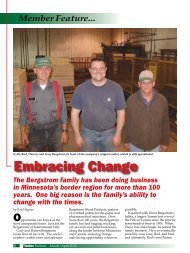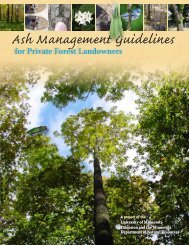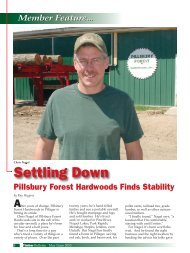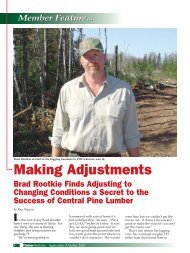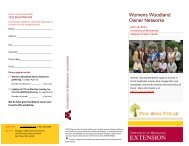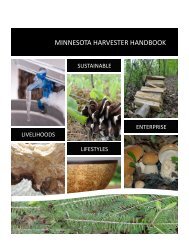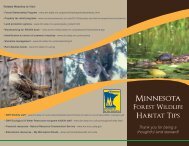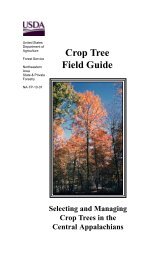Ash Management Guide for Private Forest Landowners
Ash Management Guide for Private Forest Landowners
Ash Management Guide for Private Forest Landowners
You also want an ePaper? Increase the reach of your titles
YUMPU automatically turns print PDFs into web optimized ePapers that Google loves.
occurs leading to extensive bank failurescausing high turbidity levels in thestream water.Trees can help reduce the amount ofbank failure because their roots extend 5to 7 feet below the bank. They bind thesoil and keep the bank drier during thegrowing season with their high evapotranspiration.Bank failures may extend10 to some 300 feet away from the riverdepending on how deeply the river hasincised.Along the Little<strong>for</strong>k River in northernMinnesota near the town of Little<strong>for</strong>k,the river has downcut nearly 8 1 ⁄2 feetand yields one of the highest turbidityratings in the state. Bank failures alongthe Little<strong>for</strong>k River extend up to 350 feetfrom the river. Along incised river channels,<strong>for</strong>ests should be managed <strong>for</strong> latesuccession <strong>for</strong>est stands with near 100%<strong>for</strong>est canopies. The width of these <strong>for</strong>estsshould be about the width of bankfailures seen along the channel.Special wildlife considerationsSpecies that are most likely associatedwith the Floodplain <strong>Forest</strong> includethe Cerulean warbler, red-shoulderedhawk , red-bellied woodpecker (southexpanding north), great blue heron,green heron (more south), blue-graygnatcatcher (south), prothonotarywarbler. Amphibian and reptile speciesinclude: blanding’s turtle, wood turtle,wood frog, leopard frog, and minkfrog. Mammals include the red bat andsilver-haired bat. Note that many ofthese species use other habitats, in additionto the floodplain <strong>for</strong>est.Chapter 5The Native PlantCommunitiesFloodplain<strong>Forest</strong> SystemSurvey Recommendations: Floodplain <strong>Forest</strong>Hydrology is impacted more by natural drainage than tree loss. Death orremoval of ash will change stream morphology. Better water drainage in thesesites will promote tree replacement.When a harvest is viable, select harvest may be the best silvicultural practicein the Floodplain <strong>Forest</strong>. Harvest only when ground is frozen or dry. On qualitysites continue to manage <strong>for</strong> quality ash. On poor sites do not harvest unless aharvest achieves specific objectives. <strong>Ash</strong> phloem reduction strategy is meant<strong>for</strong> EAB management not ash management, but it could be considered whenmanaging these stands as one of many considerations.Recommended replacement trees (as ranked by the experts):GLOSSARYmorphology: The externaland internal <strong>for</strong>m andstructure of whole plants,organs, tissues, or cells.select harvest: A cutting thatremoves only a portion of treesin a stand.Northern Floodplain <strong>Forest</strong>(10 out of 17 species)• American elm (DED resistant)• Silver maple• Basswood• Bur oak• Swamp white oak• Balsam fir• Box elder• Cottonwood• River birch• Paper birchSouthern Floodplain <strong>Forest</strong>(11 out of 17 species)• Swamp white oak• Cottonwood• American elm (DED resistant)• Silver maple• Basswood• Black walnut• River birch• Bitternut hickory• Box elder• Hackberry• Rock elm43



